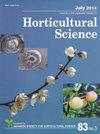Analysis of Scents Emitted from Flowers of Interspecific Hybrids between Carnation and Fragrant Wild Dianthus Species
Journal of The Japanese Society for Horticultural Science
Pub Date : 2013-04-01
DOI:10.2503/JJSHS1.82.145
引用次数: 11
Abstract
Most modern carnation (Dianthus caryophyllus L.) cultivars have weak fragrances dominated by the scent of methyl benzoate. Wild Dianthus species with strong or unique scents may be useful gene resources for the improvement of carnation fragrances. We investigated the scents of interspecific hybrids between carnations and fragrant wild species by gas chromatography-mass spectrometry (GC-MS), and evaluated the usefulness of wild species for fragrant breeding in carnations. Dianthus hungaricus, which produced large amounts of various benzenoids, was crossed with a carnation with a floral scent dominated by methyl benzoate, but benzenoid diversity was not increased in the interspecific hybrid. We also analyzed some existing interspecific hybrids. Dianthus superbus var. longicalycinus had high amounts of β-ocimene and β-caryophyllene. These terpenoids were acquired as principal scent compounds by some interspecific hybrids between this species and a carnation lacking terpenoids. Three unidentified wild species (Dianthus sp. 4, 5, and 6) emitted high amounts of benzenoids, including eugenol, benzyl alcohol, methyl o-anisate, and methyl salicylate. These benzenoids were also detected in interspecific hybrids between carnations and the wild species, and the amounts were increased compared to the parental carnation. The emission of these scent compounds of wild Dianthus species was inherited by most hybrids lines; the variety and amounts of scent compounds tended to increase compared to parental carnations, although there was no general hereditary pattern. As we actually sensed the fragrances of the principal compounds from some hybrid flowers, the usefulness of interspecific hybridizations for the improvement of flower fragrances was confirmed. Dianthus superbus var. longicalycinus and Dianthus sp. 4, 5, and 6 seemed promising resources regarding the addition of terpenoids and the increase in benzenoid variation in the floral volatiles of carnations.康乃馨与野生香石竹种间杂交花散发香味分析
大多数现代康乃馨(Dianthus caryophyllus L.)品种具有以苯甲酸甲酯气味为主的弱香味。具有强烈或独特香味的野生石竹可能是改良康乃馨香味的有用基因资源。采用气相色谱-质谱联用技术(GC-MS)对康乃馨与芳香野生种种间杂种的气味进行了研究,并评价了野生种在康乃馨芳香育种中的应用价值。将产生大量各种苯类物质的匈牙利石竹与以苯甲酯为主花香的康乃馨杂交,但在种间杂交中苯类物质的多样性没有增加。我们还分析了一些现有的种间杂交种。石竹中β-辛烯和β-石竹烯含量较高。这些萜类化合物是由本种与不含萜类化合物的康乃馨种间杂交获得的。三种未确定的野生物种(石竹属4、5和6)释放出大量的苯类化合物,包括丁香酚、苯甲醇、邻茴香酸甲酯和水杨酸甲酯。在康乃馨与野生康乃馨的种间杂交中也检测到这些苯类化合物,其含量比亲本康乃馨有所增加。野生石竹种的这些气味化合物的释放可以遗传给大多数杂交系;与亲本康乃馨相比,气味化合物的种类和数量倾向于增加,尽管没有普遍的遗传模式。通过对一些杂交花中主要化合物的香味实测,证实了种间杂交对改善花香味的有效性。从添加萜类化合物和增加康乃馨花挥发物中苯类变异的角度来看,长萼石竹和石竹4、5、6似乎是有前景的资源。
本文章由计算机程序翻译,如有差异,请以英文原文为准。
求助全文
约1分钟内获得全文
求助全文
来源期刊
自引率
0.00%
发文量
0
审稿时长
>36 weeks

 求助内容:
求助内容: 应助结果提醒方式:
应助结果提醒方式:


